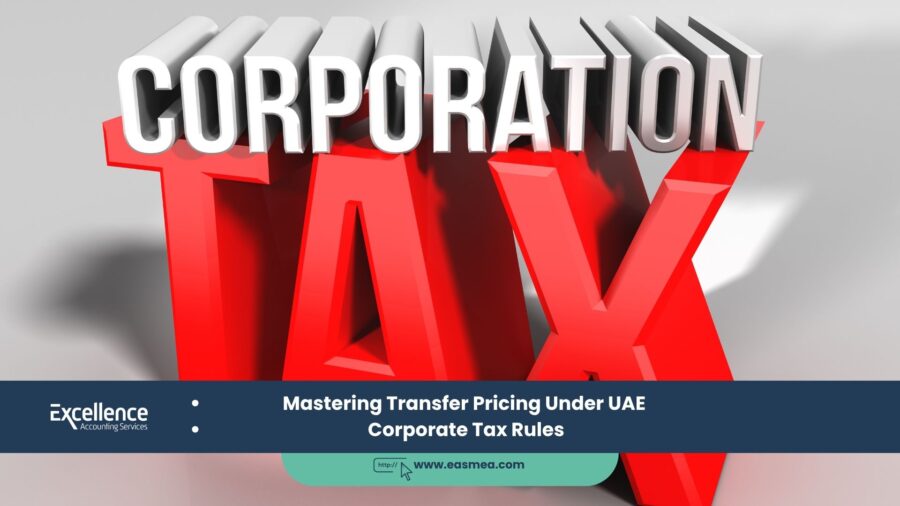Mastering Transfer Pricing Under UAE Corporate Tax Rules
With the introduction of the UAE’s Corporate Tax (CT) regime, businesses are navigating a new lexicon of financial compliance. Of all the new concepts, none is more critical—or more misunderstood—than Transfer Pricing (TP). Far from being a niche concern for multinational giants, TP regulations are a core component of the UAE CT law that applies to businesses of all sizes, including SMEs and Free Zone entities. At its heart, Transfer Pricing is about ensuring fairness and preventing the artificial shifting of profits to low-tax environments.
- Mastering Transfer Pricing Under UAE Corporate Tax Rules
- Part 1: The Cornerstone - Understanding the Arm's Length Principle
- Part 2: Who Are "Related Parties" and "Connected Persons"?
- Part 3: The Five Approved Transfer Pricing Methods
- Part 4: Documentation - Your Compliance Armour
- What Excellence Accounting Services (EAS) Can Offer
- Frequently Asked Questions (FAQs)
- Navigate Transfer Pricing with Confidence.
For any UAE business that transacts with a ‘Related Party’—be it a parent company, a subsidiary, or another business under common control—understanding and applying TP rules is now a non-negotiable requirement. The Federal Tax Authority (FTA) has been given significant power to scrutinize these transactions and impose adjustments and penalties for non-compliance. This comprehensive guide is designed to demystify Transfer Pricing for UAE businesses. We will break down the foundational “arm’s length principle,” detail the approved pricing methods, clarify your documentation obligations, and provide practical insights for mastering this crucial aspect of the new tax landscape.
Key Takeaways on UAE Transfer Pricing
- The Arm’s Length Principle is Mandatory: All transactions between Related Parties must be priced as if they were between independent, unrelated entities.
- Broad Scope: TP rules apply to domestic and cross-border transactions, affecting mainland LLCs, Free Zone entities, and SMEs with related-party dealings.
- Documentation is Your Defence: While only larger businesses need to prepare formal Master and Local Files, all businesses must be able to justify their TP policies if challenged by the FTA.
- Five Approved Methods: The UAE has adopted the five internationally recognized OECD Transfer Pricing methods to determine arm’s length pricing.
- Significant Penalties for Non-Compliance: The FTA can re-calculate your taxable income and impose substantial penalties if your transfer prices are found to be inconsistent with the arm’s length principle.
Part 1: The Cornerstone – Understanding the Arm’s Length Principle
The entire edifice of Transfer Pricing rests on a single, powerful concept: the Arm’s Length Principle. This principle is enshrined in Article 34 of the UAE Corporate Tax Law.
Simply put, the price of a transaction between related parties should be the same as the price that would have been charged if the transaction had occurred between two independent, unrelated parties under similar circumstances.
Think of it this way: if your manufacturing company sells a product to an independent distributor, you will negotiate the highest possible price to maximize your profit. However, if you sell that same product to your own distribution subsidiary in a 0%-tax Free Zone, you might be tempted to sell it at a very low price. This would artificially reduce the profit in your 9%-tax mainland company and shift that profit to the tax-free entity. The arm’s length principle forbids this, requiring you to charge your subsidiary the same market price you would charge the independent distributor.
Part 2: Who Are “Related Parties” and “Connected Persons”?
You cannot apply the arm’s length principle without first identifying who you need to apply it to. The law defines two key groups:
Related Parties (Primarily Juridical Persons)
This refers to two or more entities that are linked through ownership or control. This includes:
- A parent company and its subsidiaries.
- Two or more subsidiaries under a common parent company (“sister companies”).
- An individual who owns 50% or more of two or more businesses.
- A business and its foreign Head Office or branch.
Connected Persons (Primarily Natural Persons)
This focuses on the relationship between a business and the individuals who influence it:
- The owner of the business.
- A director or officer of the business.
- Any relative of the owner or director (up to the fourth degree of kinship).
- Another business in which the owner or a related individual has a significant ownership stake.
For an SME, this means transactions like salaries paid to owners, loans given to or received from directors, and service agreements with another company owned by a close family member are all subject to TP rules. A professional due diligence review can help map out these relationships and identify all in-scope transactions.
Part 3: The Five Approved Transfer Pricing Methods
To prove a transaction is at arm’s length, you must use one of the five internationally accepted methods endorsed by the OECD and adopted by the UAE. The choice of method depends on the nature of the transaction, the availability of comparable data, and which method provides the most reliable result.
| Method | Description | Best Used For |
|---|---|---|
| Comparable Uncontrolled Price (CUP) | Directly compares the price of a transaction between related parties to the price of a comparable transaction between unrelated parties. | Transactions involving commodity-like products or services where a direct market price is readily available (e.g., selling standard grade raw materials). |
| Resale Price Method (RPM) | Starts with the price at which a product purchased from a related party is resold to an independent customer. This price is then reduced by a gross margin to arrive at an arm’s length purchase price. | Distribution and marketing activities where the reseller adds relatively little value to the product (e.g., a distributor of finished goods). |
| Cost Plus Method (CPM) | Starts with the costs incurred by the supplier in a related party transaction. A market-based markup (the ‘plus’) is then added to these costs to arrive at an arm’s length price. | Manufacturing activities or the provision of routine services where costs are easily identifiable (e.g., an in-house IT service provider charging another group company). |
| Transactional Net Margin Method (TNMM) | Examines the net profit margin (e.g., return on sales or assets) that a company earns from a related party transaction and compares it to the net profit margins earned by independent companies in similar transactions. | A wide variety of transactions, especially when direct price or gross margin comparisons are difficult. It’s one of the most commonly used methods. |
| Transactional Profit Split Method (TPSM) | Divides the combined profit from a highly integrated transaction between the related parties based on their relative contributions. | Complex transactions where both parties contribute unique and valuable intangibles (e.g., joint development of a new technology). |
Selecting and applying the most appropriate method often requires deep economic analysis and benchmarking studies, a core component of strategic CFO services.
Part 4: Documentation – Your Compliance Armour
While the arm’s length principle applies to everyone, the formal documentation requirements are tiered based on the size of the business.
1. Transfer Pricing Disclosure Form
This is a form that must be filed along with your annual Corporate Tax return. You must complete it if you have had any transactions with Related Parties or Connected Persons during the tax year, regardless of the value of those transactions.
2. Master File and Local File
These are detailed, formal TP reports. You are only required to prepare and maintain them if your business meets one of two criteria:
- Your revenue in the relevant tax period is AED 200 million or more.
- You are part of a Multinational Enterprise (MNE) Group with a total consolidated group revenue of AED 3.15 billion or more.
Even if you fall below these thresholds, the FTA can still request information to prove your transactions are at arm’s length. Therefore, maintaining some level of documentation to support your pricing is a prudent practice for all businesses. A robust accounting system implementation is the first step to ensuring you can even capture the data needed for this documentation.
Platforms like Zoho Books provide the granular detail needed for your core accounting and bookkeeping, which is the data source for any TP analysis. Without accurate books, TP compliance is impossible.
What Excellence Accounting Services (EAS) Can Offer
Mastering Transfer Pricing requires a blend of tax law knowledge, economic analysis, and strategic foresight. EAS provides comprehensive support to ensure you are compliant and optimized:
- TP Applicability and Risk Assessment: We analyze your corporate structure and transactions to identify TP risks and determine your specific documentation requirements.
- Benchmarking and Method Selection: Our experts conduct economic analysis to benchmark your transactions against market data and help you select and apply the most appropriate TP method. A correct business valuation is key.
- Documentation Preparation: We assist in preparing robust and defendable Transfer Pricing documentation, including the Local File, Master File, and the annual Disclosure Form.
- Policy Design and Implementation: We work with you to design and implement clear inter-company agreements and TP policies that align with your commercial objectives and stand up to scrutiny. Our internal audit services can review these policies.
- FTA Audit Support: In the event of an inquiry or audit from the Federal Tax Authority, we provide expert support to defend your TP position.
- Holistic Tax Advisory: We integrate your TP strategy with your overall Corporate Tax and VAT planning to ensure a cohesive and efficient tax position.
Frequently Asked Questions (FAQs)
Yes. The UAE’s Transfer Pricing rules apply to both domestic and cross-border transactions. If you have two mainland companies transacting with each other, and both are subject to the 9% tax rate, the risk of profit shifting is lower, but you are still legally required to price the transaction at arm’s length and report it on your disclosure form.
While you may not be required to prepare a full Master and Local File, the arm’s length principle itself is mandatory for you. The risk is that during a tax audit, if you cannot justify your pricing, the FTA can impose its own adjustments, leading to a higher tax bill plus penalties. For key transactions (e.g., significant management fees, large loans), conducting a basic benchmarking analysis is a prudent, defensive investment.
Think of “Related Party” as applying primarily to entity-to-entity relationships based on control or ownership (e.g., parent-subsidiary). “Connected Person” primarily applies to entity-to-individual relationships, focusing on owners, directors, and their relatives. This means your salary as an owner-manager or a loan to your brother is a transaction with a Connected Person and falls under TP rules.
This is a common challenge. When a direct price comparison (CUP method) is not possible, you must move to other methods like the Cost Plus Method (for services) or the TNMM. This involves building a detailed understanding of your costs and then researching what profit markup or net margin independent companies in a broadly similar industry earn. This requires access to financial databases and expert economic analysis.
Yes, absolutely. A salary paid to an owner, director, or their relative is a transaction with a Connected Person. The salary must be at a market rate for the services being provided. You cannot pay yourself an artificially high salary to reduce the company’s taxable profit. You should be prepared to justify the amount based on your role, experience, and what a third-party company would pay for a similar position. Proper payroll services can help document this correctly.
If the FTA determines that your transaction was not at arm’s length, they have the authority to make a TP adjustment. They will recalculate your taxable income based on what they determine the arm’s length price should have been. This will result in additional Corporate Tax being due, plus administrative penalties for the incorrect tax filing and potentially late payment penalties.
This is a high-risk area. If your mainland company (taxable at 9%) pays an inflated fee for services from your Qualifying Free Zone Person (potentially taxable at 0%), you are shifting profit out of the tax net. The FTA will scrutinize these transactions very closely. The price must be at arm’s length, and you must have robust documentation to prove it, otherwise, you risk not only a TP adjustment but also potentially jeopardizing your QFZP status.
The disclosure form requires you to report specific details about your transactions with Related Parties and Connected Persons. You will need to identify the counterparty, state their relationship to you, and provide the nature and value of the transactions conducted during the year. It essentially serves as a flag to the FTA, highlighting that you have engaged in related-party dealings that may warrant further scrutiny.
No. If you are required to prepare them, you do not need to submit them automatically with your tax return. However, you must have them ready by the tax return filing deadline and be prepared to submit them to the FTA within 30 days of a request.
Yes. Financial transactions are a key focus of Transfer Pricing. Any loan between related parties must have an arm’s length interest rate. You cannot provide an interest-free loan to a subsidiary to fund its operations if an independent party would have charged interest. You must be able to justify the interest rate charged (or not charged) based on market rates, considering factors like the borrower’s creditworthiness, the loan’s term, and the currency.
Conclusion: From a Compliance Burden to a Strategic Tool
Transfer Pricing in the UAE is a new and complex field, but it should not be viewed solely as a compliance burden. A well-designed and documented TP policy provides certainty, mitigates risk, and supports the commercial objectives of your business group. By taking a proactive approach—identifying your risks, documenting your policies, and seeking expert advice—you can master these new rules and turn a potential challenge into a cornerstone of robust financial governance.




